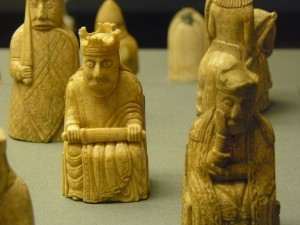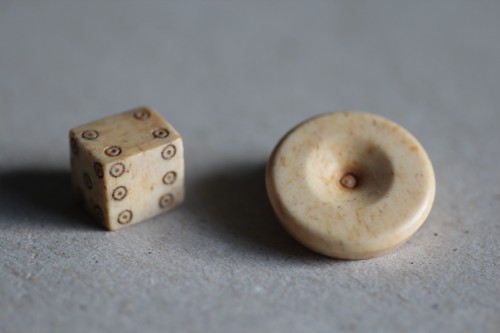Welcome to Purple Pawn, covering games played around the world by billions of people every day.
 Carbon dating of walrus bones found in Iceland may lend some support to the theory that the famous Lewis chessmen originated in Iceland instead of Norway. The Lewis chessmen, discovered in 1831 in the Outer Hebrides, are made mostly of Walrus ivory and are one of the few surviving examples of complete Medieval Chess sets. Most scholars, focusing on the style of the carvings, believe that the Lewis chessmen were produced in Norway. An alternative theory, however, asserts that the chessmen more likely originated in Iceland because only there were bishop pieces based on church figures, as is the case with the Lewis set. Now some believe that carbon dating of a series of walrus bones found over a period of years proves that Walrus ivory was available in Iceland at the time the Lewis chessman were made.
Carbon dating of walrus bones found in Iceland may lend some support to the theory that the famous Lewis chessmen originated in Iceland instead of Norway. The Lewis chessmen, discovered in 1831 in the Outer Hebrides, are made mostly of Walrus ivory and are one of the few surviving examples of complete Medieval Chess sets. Most scholars, focusing on the style of the carvings, believe that the Lewis chessmen were produced in Norway. An alternative theory, however, asserts that the chessmen more likely originated in Iceland because only there were bishop pieces based on church figures, as is the case with the Lewis set. Now some believe that carbon dating of a series of walrus bones found over a period of years proves that Walrus ivory was available in Iceland at the time the Lewis chessman were made.
Among the items found at the excavation of a Roman village in Gernsheim, Germany are dice and game pieces. The pieces date back to the second century and are made of bone [image credit: Thomas Maurer].
Mikhail Tikh was fascinated by the idea that dice originated with uncarved animal bones. Yet when he tried to procure for himself a set of traditional knucklebones, he found it quite difficult. So to make it a bit easier on the next person who might be interested in some hands-on playing with history, Tikh cleaned and scanned some sheep bones, then uploaded the 3D models to Shapeways. A set of four in white nylon runs $27.50.
1 Comment
Sorry, the comment form is closed at this time.
Trending
- Massdrop.com
- Oh the Irony—Illuminati Card Game Continues to Inspire Conspiracy Theorists
- Home
- Footprints, an Educational Ecology Game
- USPS Adds Board Game Flat Rate Box
- Baila, the Estonian Drinking Card Game
- Crystal Caste Wins Dice Patent Suit Against Hasbro
- Mirror Game, Red and Blue
- Are Board Games Dangerous?
- The Truth About Dominoes On Sunday in Alabama
Archives
Most Popular Articles
- Oh the Irony—Illuminati Card Game Continues to Inspire Conspiracy Theorists
- The 20 Most Valuable Vintage Board Games
- The Truth About Dominoes On Sunday in Alabama
- Sequence Game, and Variants
- USPS Adds Board Game Flat Rate Box
- Baila, the Estonian Drinking Card Game
- The 13 Most Popular Dice Games
- Are Board Games Dangerous?
- Guess Who? The Naked Version
- What Happened to the Jewel Royale Chess Set?
Recent Posts
- Toy Fair 2019—Breaking Games
- Talisman Kingdom Hearts Edition
- Toy Fair 2019—Winning Moves
- Toy Fair 2019—Games Workshop
- Toy Fair 2019—Star Wars Lightsaber Academy
- Toy Fair 2019—Stranger Things Games
- Toy Fair 2019—HABA
- Licensing Roundup
- Game Bandit
- 2018 A Difficult Year For Hasbro But Not For D&D Or MtG
Recent Comments
- on Toy Fair 2019—Winning Moves
- on Game Bandit
- on Second Look—Dungeons & Dragons Waterdeep Dragon Heist
- on Crowdfunding Highlights
- on Beyblade SlingShock
- on Game Bandit
- on Game Bandit
- on Watch This Game!, the Board Game Review Board Game
- on Second Look—Vampire: The Masquerade 5th Edition
- on Palladium Books Loses Robotech IP License, Cancels Five-Year-Overdue Robotech RPG Tactics Kickstarter






I’m totally printing out some Knucklebones once I get some more ABS filament.